Sheesham wood offers exceptional durability and rich grain patterns, making it ideal for sturdy, long-lasting chairs. Maple wood is prized for its smooth texture and lighter color, providing a sleek, modern finish for chair designs.
Table of Comparison
| Property | Sheesham Wood | Maple Wood |
|---|---|---|
| Durability | Highly durable, resistant to decay and termites | Strong and hard, moderate resistance to wear |
| Grain Pattern | Distinctive rich grain with natural swirls | Fine, consistent, and smooth grain |
| Color | Golden brown to dark brown with natural luster | Pale cream to light reddish-brown |
| Workability | Moderately easy to work with hand and machine tools | Easy to machine and finish |
| Weight | Medium to heavy density (~770 kg/m3) | Medium density (~700 kg/m3) |
| Price | Moderate to high cost | Affordable and widely available |
| Ideal Use for Chair | Strong structural frame, aesthetic-rich appearance | Lightweight frame, smooth finish, easy customization |
Introduction to Sheesham and Maple Wood
Sheesham wood, also known as Indian Rosewood, is prized for its rich grain patterns, durability, and natural resistance to decay, making it ideal for high-quality furniture such as chairs. Maple wood, characterized by its fine, uniform texture and light color, offers strength and smoothness, often preferred for modern and minimalist chair designs. Both woods provide excellent longevity and aesthetic appeal, but Sheesham's natural oils enhance moisture resistance, whereas Maple's hardness ensures excellent wear resistance.
Key Characteristics of Sheesham Wood
Sheesham wood, known for its durability and rich grain patterns, offers excellent resistance to decay and insect attacks, making it ideal for high-quality chairs. Its natural oils provide a smooth finish and a warm, dark brown hue with striking golden streaks, enhancing aesthetic appeal. Compared to maple, Sheesham is denser and heavier, contributing to robust, long-lasting furniture with a distinctive, elegant appearance.
Key Characteristics of Maple Wood
Maple wood is known for its durability, fine grain, and smooth texture, making it an excellent choice for chairs that require both strength and aesthetic appeal. Its light color ranges from creamy white to light reddish-brown, allowing for versatile finishes that enhance the wood's natural beauty. Resistance to abrasion and impact ensures that maple chairs maintain their quality and appearance over time, offering long-lasting comfort and style.
Durability: Sheesham vs Maple
Sheesham wood, known for its high density and natural oils, offers superior durability and resistance to wear, making it an excellent choice for long-lasting chairs. Maple, a hardwood prized for its strength and fine grain, also provides remarkable resilience and withstands heavy use without deforming. Comparing durability, Sheesham's natural oil content gives it added protection against moisture and pests, whereas Maple's dense fiber structure contributes to excellent shock resistance and stability.
Aesthetic Appeal: Grain and Color Comparison
Sheesham wood features rich, dark brown hues with distinctive natural grain patterns that lend chairs a warm, rustic aesthetic ideal for traditional or eclectic interiors. Maple wood offers a lighter, creamy color with subtle, uniform grain patterns, creating a sleek and modern look suitable for minimalist or contemporary chair designs. The choice between Sheesham and Maple largely depends on the desired visual impact, with Sheesham providing bold, textured appeal and Maple delivering smooth, understated elegance.
Workability for Chair Making
Sheesham wood offers excellent workability for chair making due to its moderate hardness and natural oils that facilitate smooth cutting and sanding, resulting in a durable finish. Maple is harder and denser, which can make it more challenging to work with but provides superior strength and fine detailing capabilities ideal for crafting sturdy chairs. Both woods respond well to adhesives and finishes, but Sheesham's natural resistance to wear makes it a preferred choice for intricate chair designs requiring long-term durability.
Maintenance and Longevity
Sheesham wood offers exceptional durability and natural resistance to pests, making it low-maintenance and ideal for long-lasting chair construction. Maple wood, known for its hardness and smooth grain, requires regular polishing to maintain its appearance but resists wear and tear effectively. Choosing Sheesham ensures extended chair longevity with minimal upkeep, while Maple demands more consistent care to preserve its finish and strength.
Cost and Availability
Sheesham wood, known for its durability and rich grain patterns, is generally more expensive than maple due to its limited availability primarily in India and Southeast Asia. Maple, widely sourced in North America, offers a more affordable and readily available option for chair manufacturing, making it popular in mass production. Cost-effectiveness and regional availability make maple a preferred choice for budget-conscious consumers, while sheesham appeals to buyers seeking premium quality and distinctive aesthetics.
Environmental Impact and Sustainability
Sheesham wood, sourced from Dalbergia trees native to South Asia, is prized for its durability and longevity, supporting sustainable forestry when harvested responsibly under certified programs like FSC. Maple, commonly found in North American forests, offers a renewable option due to faster growth rates and the potential for managed replanting, enhancing carbon sequestration benefits. Both woods contribute to environmentally friendly furniture choices, but Sheesham's slower growth requires stricter sourcing controls to minimize deforestation, while Maple's abundance supports more consistent sustainable supply chains.
Which is Better for Chairs: Sheesham or Maple?
Sheesham wood offers rich grain patterns, natural durability, and resistance to termites, making it ideal for ornate and traditional chair designs. Maple is lauded for its hardness, smooth finish, and consistent grain, providing robust support and modern aesthetics suitable for everyday use. For chairs requiring high strength and subtle elegance, maple is often better; for those prioritizing unique appearance and natural resistance, Sheesham is preferable.

Infographic: Sheesham vs Maple for Chair
 azmater.com
azmater.com